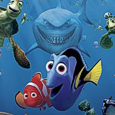Pixar Animation Studios/Walt Disney Pictures (May 30 2003), Walt Disney Home Entertainment (November 4 2003), 2 discs, 100 mins plus supplements, 1.78:1 anamorphic widescreen, Dolby Digital 5.1 EX Surround, Rated G, Retail: $29.99
Storyboard:
As with many films to emerge from the Disney Studios over the years, it’s the death of a parent that sets the plot in motion, when clownfish Nemo’s mother and almost all of her eggs are lost to a barracuda attack at their home under the sea on the great barrier reef. Thankfully, at this point, little Nemo has yet to be born and escapes the predator unharmed, the only surviving egg. Marlin, his clownfish father, lavishes extra care and attention on Nemo as he grows older – something that does not always sit easy with the little fish himself, especially when his dad’s overprotecting nature embarrasses him on his first day of school. Nemo swims off, trying to prove that he can take care of himself, but soon gets tangled up (quite literally) in a diver’s net and taken away from Marlin and the school. His dad tries to keep up with the divers’ boat but loses them, with the only clue to their destination being a swim mask that falls to the bottom of the ocean.

Marlin meets up, and is teamed with Dory, who suffers from short-term memory loss (providing many of the film’s best and unexpected moments of comedy) and together they vow to find Nemo and bring him home. Meanwhile, our little flipper has ended up in the fish tank of an Australian dentist – a tank filled with other fish desperate to escape due to their being tortured by the dentist’s niece, Darla. Like Sid in Toy Story, Darla is a bit of a psycho (complete with Bernard Herrmann’s unforgettable string theme), and deadly to all fish. Will Marlin, Dory, a team of stoner-surfing turtles and a crazy pelican be able to reach Sydney in time and stop Nemo from becoming sushi? The swim to shore is on…
The Sweatbox Review:
The biggest film of its year, live-action or animated, comes to DVD in a great little package that does justice to the movie itself and continues the standard set by previous Disney/Pixar collaborations on disc!
The fact that my copy of Nemo came in just a couple of days after having seen it in the theater (no, I wasn’t a late-goer, but it had just come out here in the UK) made it even more exciting. As with Sylvain Chomet’s recent Belleville Rendezvous/The Triplets Of Belleville, Nemo is a film one wants to watch right away again, not just for the sheer pleasure, but to study it, and take it all in. Already this week I’ve spent over $80 on Nemo: from $35 to see it in a digital theater (I paid for a friend also), $20 for the soundtrack CD, and now $30 for the DVD – but I’ve a ways to go before I’m all Nemo’d out! Still, this new disc should do the trick, what with its extensive line up of extras and bonuses. But at the center of it all is a fairly small story that has a lot of heart. In fact, the story is deceptively simple, and is classic Disney in many ways: family suffer tragedy, family must undergo further turmoil on a physical and emotional journey that, at the end of their quest, resolves their personal issues and makes them better people. Or, in Nemo’s case, fish. But you get the idea.
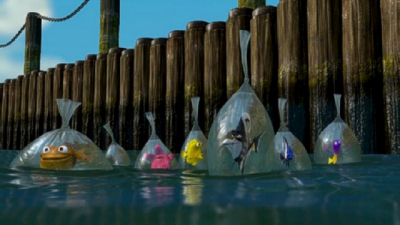
Building on Pixar’s successes, they can seemingly only go upwards. To be honest, I was becoming a little tiresome of the double-acts that seem to populate all of their films. A Bug’s Life added a few additional elements, and next year’s The Incredibles looks to be a complete and welcome change of pace. Here I found the Albert Brooks-Ellen DeGeneres partnership offered much more than the usual, very much stuck-in-the-same-mould as produced Woody and Buzz, and Mike and Sully. The playing here meant that, while they were together for much of the film, it wasn’t so buddy-buddy as before, with Marlin acting as a father the whole way through, and Dory as his sweet-natured but forgetful friend. That there is never any allusion to them becoming romantic partners helps this relationship remain valid and believable (for a fish movie!) and helps the audience tap into this amazing world and keep up our suspension of reality. Sitting with my friend, who just became a dad himself, it was interesting to note which scenes played best with him, and for the most part it seemed to be the ones where characters bonded.
For me, I love the Pixar humor – and Nemo has it in bucket loads. The trick is to watch whoever on screen is NOT doing the talking, and you’ll find that you’ll get twice the laughs! Backgrounds in Pixar’s films are also things to check out, especially on DVD, and here there are some great details to find (such as trinkets and characters from upcoming movies Cars and The Incredibles). Dialogue in Pixar films is also always very strong, and the actors help pay off any lacklustre lines that are to be found here – not that there are many! The script bounces along, and always tops itself up if there is a lull approaching.
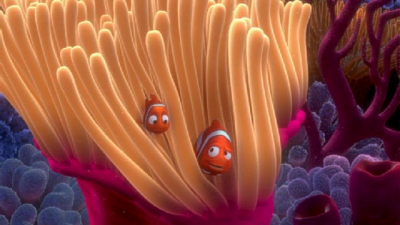
On a digital theater screen, I did find the image had that usual, overly too clean look that plagues the Pixar films. The company also markets the industry standard computer tool RenderMan, an application that is used by many of the tops effects people in the business to compose shots and place CG objects into live-action environments. Strangely, they seem to find using this powerful application in their own movies a little “difficult”: on more than one occasion I have been jolted out of a Pixar movie by some fills and textures that just do not seem “finished”. My least favorite character to date in this respect has been Mike from Monsters Inc, a CG character who does not seem organic to me at all. This may also be, of course, because he is placed next to something so amazingly lifelike throughout the film (Sully) that he comes off a poor second. With Nemo, I was pleasantly surprised to find that pretty much all elements meshed quite nicely together. Only in the opening sequences did I think that perhaps the fish were too clear overall to be under the sea, but once the visual approach had settled in, I was hooked for the ride and did reason that, if it had been too real, we wouldn’t have been able to see what was going on!
Here, character animation in CG is raised up several notches. There are moments when dialogue does not have to be spoken to convey an emotion – something that CG usually handles by playing everything broad. Subtlety is in great supply in the film, and the voice cast get to play a wide range of emotions. This is also probably Pixar’s first “big cast” film. While the others had a very decent array of talent, such as A-listers Tom Hanks, Tim Allen, John Goodman and Billy Crystal, Finding Nemo has the kind of cast that is usually drawn to DreamWorks animation-type line-ups. As Marlin, Brooks portrays the father with several layers, usually missing in his caricatures he sometimes plays in The Simpsons. DeGeneres practically plays herself, and comes off best with some of the funniest vocals. Speaking whale is a high point. As for the rest, well, how’s this: Willem Dafoe, Geoffrey Rush (making something of a Disney career for himself with this and Pirates Of The Caribbean), Barry Humphries (Dame Edna him/herself), Hulking Eric Bana, Austin Pendleton (The Muppet Movie), Elizabeth Perkins, and animation stalwarts Brad Garrett (various Disney toon series), Stephen Root (King Of The Hill, Ice Age), plus a couple of Pixar crew as additional voices. Storyman Joe Ranft is Jacques, while director Andrew Stanton voices Crush, the memorable turtle who helps Marlin and Dory and almost steals the film! Making his customary Pixar appearance is John Ratzenberger, and way down in the list is Nicholas Bird, the son of The Incredibles and Iron Giant director Brad, here making his first foray into animation.

My one small bugbear with the film overall was that it appeared to have three endings, one too many for me. Once Nemo has been found, I can see the point of including his final rescue of the other fish in the fisherman’s net, but it did feel a little tagged on. It’s only really there to prove that he can fend for himself, something that he does in fact do repeatedly throughout the film, and as an additional action sequence, I just wanted things to wrap up a little quicker. Perhaps some of the problem was that the fish in the net on the whole were indistinguishable from each other, and after an hour and a half of very strong, very entertaining characters and personalities it maybe needed a “comedy fish” within the group to help carry the sequence along. That said, it rounds the film up and finished things on a high note.
There are plenty of such high note moments throughout the film, as well as the many in-jokes and pokes at Pixar and Disney’s past (the Pizza Planet truck makes another appearance, as well as the mermaid from Knick Knack). One of the boats the characters fly past in the dock is named Skiff-A-Dee-Doo-Dah (another is The Surly Mermaid) and a quick rendition of A Whale Of A Tale made me laugh – it’s Ned the sailor’s song from 20,000 Leagues Under The Sea (1954), the Disney film that featured a captain named Nemo. There are also references to Aardman Animation’s trademark style in the seagulls, with their pointy heads and dotted eyes, as well as their Wallace And Gromit characters, who live at 62 West Wallaby Street in those films, while the dentist’s office is located at “nearby” 42 Wallaby Way! Most obvious, of course, is Barry Humphries’ shark, Bruce, named for the mechanical monster in Jaws (1975). Also, be sure to stick around for the final credits. Though we are not treated to any of Pixar’s famous outtakes this time around, the scroll has been tinted with some colourful characters from the film (plus one from another Pixar hit) that interplay within the text. There’s also a very funny gag that plays right at the end, which is truly worth waiting around for.

There is so much to Finding Nemo, especially in the much talked about visuals, that is very easy to like. It’s light years ahead of what was possible in such films as The Incredible Mr Limpet, and most certainly contains the funniest fish in a movie since Monty Python’s The Meaning Of Life! Raising the bar for animated movies once again, it will be interesting to see how DreamWorks combats Pixar’s work here with their own fishy flick, Shark Tale (an undersea mob comedy). As for Nemo itself? Well, this movie can only be described adequately as “a fish called wonder”!
Is This Thing Loaded?
If you want fun extras on a Disney DVD, then a Pixar disc is the plaice for you! We’re straight into the main menu, where I stayed for the entire two-minute intro simply because it was so funny. The characters from the movie all provide new vocals for each menu, and it’s amusing just to sit and listen to them play out. Each selection features a little “Nemo icon” at the bottom left of the screen which, when clicked, clears the menu choices out of the way and turns the screen into “virtual aquarium” (at least that’s what the packaging says). It does feel somewhat like that, but it’s also a great excuse to examine Pixar’s backdrops!

The first video based extra is a short intro from directors Andrew Stanton and Lee Unkrich. Setting up the set, they offer up a quick “tour” of what to expect over the two discs and point out the aquarium icon. The backdrops are also accessible in the Bonus Features menu, revealing that there are seven to see on this disc. Also hidden in the Bonus menu are a couple of Easter Eggs (I won’t spoil here) that hide some fun little things.
For the first time in Pixar’s history, a documentary crew followed the production through from conception to completion. The results are the 25-minute doc Making Nemo, which even for long-time animation buffs, is a fascinating look into the production process at the Studio. Presented in 4×3, the image has been retained inside a 16×9 anamorphic frame, meaning less flipping of display modes for those with widescreen sets – nice. Part EPK, part meaty doc, the film really is worth catching, and features interviews with the main players as well as research footage, test animation and the general craziness that is Pixar Animation Studios. What is not pointed out anywhere is that fact that this documentary has actually been chapter indexed, though I could not find any info marking this out. It packs in a great deal and covers a lot of in-depth ground for a relatively short piece (such as the dangers of making Nemo’s world too real), and the pacey editing keeps things moving along. Interesting and fun.
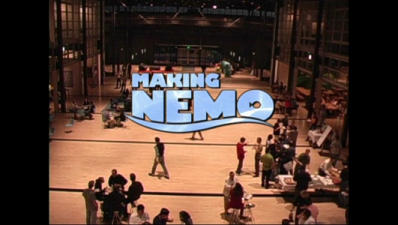
Design Galleries offers up four additional options: Art Review, Characters, Environments and Color Script. Presented in two ways (with music or with commentary), Art Review is an over 8-minute piece that takes a look at pre-production concept art produced for the film. Although the music only version is nice and showcases more of Thomas Newman’s score, the commentary (from production designer Ralph Eggleston, character art director Rick Nierva and shading art director Robin Cooper) makes more sense, especially as the three intro themselves with drawn caricatures of themselves and talk us through the paintings. The music score is also present on this version, and it seems the only one to see, as images can be still-framed for closer inspection.
Running almost 7-minutes, Characters is a great way to study the sculpted maquettes that inspired the animators while creating the movie. Each character from Marlin, Dory and Nemo, to Nigel and Darla is shown either as individual clips running a few seconds or as a whole. The statues are rotated once, giving us a full perspective, while hand-drawn concept art floats by in the background and around the sides. While this doesn’t allow for a close-up look at the 2D art, this is a nice new way of presenting such material. There are more concept works to be found in Environments, a series of still images that show individual backdrops and props that were created and used in the movie. There are three “locations” to explore: the Reef, the Ocean and the Harbor, each with several subsections and various images within those – plenty of amazingly intricate details to discover. Finally, the Color Script plays out over 300 of Ralph Eggleston’s original guide drawings, made to convey the mood of each individual scene. These can also be stepped through using the “next” button on the viewer’s remote.
The big attraction on disc one is the Visual Commentary, which elaborates on the footage seen in the Nemo doc as well as presenting alternate and deleted scenes within the movie. Playing along the same lines as the Treasure Planet commentary, the speakers (directors Andrew Stanton and Lee Unkrich, and co-writer Bob Peterson) come to a halt at specific moments to intro a video clip that elaborates on what they are saying. In all, this adds up to over another 30-minutes of material and, unlike the Treasure Planet commentary, does not repeat material we may have seen in other sections. Even better is the fact that these extra clips have been indexed with a separate sub-menu, which makes searching for individual segments within the commentary a breeze, as well as a Play All selection that automatically runs them through – a really good way of presenting all the available footage!
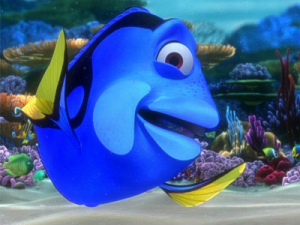
The commentary itself is what you’ll expect: interesting, never boring, insights into the production with the three filmmakers, which covers absolutely all areas of production. The speakers are placed left, center and right across the soundstage, so even when there is overlap, they all remain clear. As for the video based extras, they serve up an amazing amount of intricate detail, such as revealing that the initial tests for the anemone in the film was Monsters’ Sully’s hair thickened up a little, as well as showing the creating and lighting of the reef, voice sessions, Stanton selling the film to merchandise licensees, the differences between real and fake Aussies, particle tests, a music and sound effects only clip, a progression reel, the problems animating jellyfish, video footage of DeGeneres speaking whale, early water and swim tests, scoring session, multi-language seagulls, more concept art, and a touching tribute to animator Glenn McQueen that runs almost three minutes in itself.
To the credit of those involved in putting the disc together, there is very little overlap, and these sequences lead in and out of the commentary very easily, as well as playing fine on their own. Deleted scenes include an alternate “dream story” version of Nemo’s mother’s death, Marlin searching for Nemo’s school, an extra shark scene featuring a game played with a live mine, a not-so-nice Gill, a more transcendental take on Crush and Dory, and a longer Nemo in the sewer sequence – all shown in their original storyboard forms. Also included are some audio outtakes of Brooks trying to deliver Marlin’s joke, and DeGeneres improvising her sleeping state, which is fairly amusing, though more than just these on the voice cast overall would have been a big bonus.
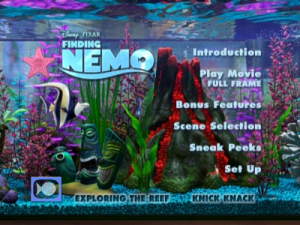
On to Disc Two, and if you’ve been wondering where all the usual plugs for other Disney product have been hidden, then wonder no more! As the disc spins for the first time, we’re treated to the theatrical teaser for Pixar’s next, The Incredibles, in a great 2.35:1 anamorphic showing. Even better is a first sneak peek at full animation for Disney’s last hope for 2D animation, 2004’s Home On The Range, which looks like it absolutely re-captures the magic of the 1990s features, complete with Alan Menken’s music, irreverent comedy and stunning, 1950s styled animation similar to The Emperor’s New Groove. Other previews include Santa Clause 2, Lion King 1 ½, Spy Kids 3-D, and a single-trailer look at three upcoming SE discs: Alice In Wonderland, Pocahontas (featuring a “new song from Mel Gibson” – could they have inserted If I Never Knew You back in?) and Lilo And Stitch.
After the trailers, we’re led into the dentist’s fish tank for a swim through of the backdrop before it finally rests to display the main menu. Here, the little Nemo icon is present again and, when selected, shows off one of four detailed layouts – this time with some extra, new character animation featuring the cast (and worth sticking around for). This disc on the whole is more of a look at the real undersea world, rather than Nemo’s make-believe. First up, and let’s get this quickly out of the way, is a full-framed, recomposed version of the movie (although it looked like a simple open matte to me, and frustratingly so as it does throw up a serious discussion on which one to go for). Whereas everything on disc one was geared toward the 16×9 viewer (anything that was shot 4×3 is placed within a 16×9 frame), on disc two, everything is pretty much 4×3-based, taking the lead from the movie.
Another intro from directors Stanton and Unkrich sets things up for the discoveries ahead, after which I went right to the Bonus Materials. Mr Ray’s Encyclopedia takes an educational (but always fun) look at the real-life stars of Finding Nemo, with live-action footage of thirteen of the species shown in the film. Playable all together, this adds up to over seven and a half minutes of material and will enhanced the viewing of the movie due to showing up the attention to detail that the crew maintained, as well as providing kids with the real knowledge of how these creatures live and survive – even if Mr Ray isn’t always too hot on his information! There is also a pretty funny Easter Egg to be found here too!
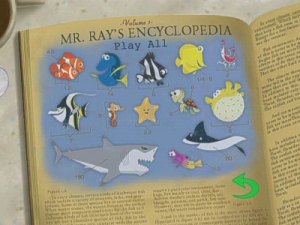
Fisharades is a fun set-top game for one or two players that is intro’d by Crush the turtle. It’s actually quite fun, being a race against time to work out which object from four the school of fish are grouping together to approximate. Not sure if it has much repeatability though, as on a second go many of the objects were very obviously the same, and I think the lack of a varied selection of random objects will probably make this a less visited section of the disc that it might have been. Storytime is a very basic (and short!) additional read-along story for smaller children, featuring Nemo and Marlin. Either playable as a read story, or able to be stepped through for self-reading, the tale is sweet and designed with illustrations that reminded me of the Little Golden Books that were issued when the film was in theaters. The read-along version is more fun, having been animated and including additional music, dialogue and songs from the film – nicely done and just right for younger audiences, running a brisk six and a half minutes.
The Behind The Scenes menu offers up a variety of further options. There’s another Dory-based Easter Egg, before heading to Character Interviews, which takes in new animation and joke cast chats with Marlin, Dory, Nemo and Bruce the shark (2:30 minutes). Studio Tour features Nemo voice Alexander Gould’s quest to find out how they turn his vocals into a fully animated character. A kids-eye view of the Pixar complex, this is a zippy five or so minute journey that takes in storyboards (“kinda looking like a big comic book”), character design, animation (“animators are kind of like actors, but we act through the computer”), lighting and effects. Though it covers much of the same ground as the documentary on disc one, this is aimed at a younger audiences and is worth checking out for its infectious Pixar spirit!
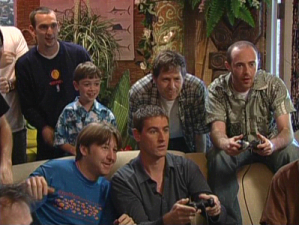
Staying in the Behind The Scenes section, Publicity shows off the teaser and trailers that helped Finding Nemo open to such box-office bonanza takings. Unfortunately, in keeping with the 4×3 nature of this disc, they are only presented in letterboxed, non-anamorphic widescreen, but my feeling is that its better to have them at all rather than not, as has been the case with some recent Disney issues. The teaser that was included in last year’s Monsters Inc disc is here, as well as three full theatrical previews (Bright Light, 3.7 Trillion Fish and Earth Surface), plus three fun facts on Bruce, Nigel and Crush that ran as TV spots. All of the trailers are well cut and evoke the feeling of the movie well, though a Play All function would have been great here, especially for the TV spots. It’s all welcome stuff though, topped off with a Print Gallery featuring 18 poster images.
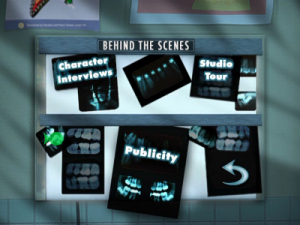
Also accessible from both the Bonus and Main menus is the much-advertised Exploring The Reef, a seven-minute look at the real world that Finding Nemo is set in. Jean-Michel Cousteau hosts the mini-doc, which starts off as one of those “round the world” pieces often shown on the Discovery Channel, but any reservation that this is going to be anything less than fun is quickly thrown out, as Cousteau is joined onscreen by Dory, Marlin and Nemo by way of new animation meshed in with the beautiful (and real of course!) live-action backgrounds. It’s a very well made extra, and features some obviously time-consuming and expensive new animation, which has been put together exclusively for the disc and is highly amusing as Cousteau tries to keep things fact-based while the cast play havoc with his narration. The animated cast themselves don’t always fit it with their real world counterparts, but to point out such shortcomings is to miss the point: this is a very fine and well-made DVD bonus, and we learn quite a few things along the way too – no bad thing!
The only fishy thing I found about the extras in the set was the inclusion of Pixar’s previously released short film Knick Knack. That’s because what is presented is not the original version, but rather a “Disneyfied” re-rendering that cleans up some of the original humor that defined its computer geek filmmakers. At the time (1989), these guys were all free and single, and knew what assets they appreciated in eyeing up an attractive lady (you can guess where their attentions lay). By 2003, they’re all married and settled down with kids and are somewhat embarrassed by their almost teenaged-outlook on the female anatomy. So a clean-up was requested in the transferring of computer files for this new presentation, which basically removes the rather obvious “charms” of a couple of well-endowed female figurines and replaces them with…well, nothing. Zip. Zilch. The short follows the attempts of a snow-globe bound snowman to break free and party with the other keepsakes on display high up on a shelf.

Part of the reason (actually, probably the ONLY reason) he wants out is to pursue the girls, and though the original caricatures were admittedly not exactly politically correct, the whole thing was done tongue-in-cheek and was an obvious joke (the girls were made of plastic, after all). That the main joke has been taken away does not detract from the comic actions of the snowman in any way, but it does subdue his initial reaction, and I’ve seen far more suggestive things on TV’s Baywatch, for example, which is a hugely successful family show. However, the short can be found in its original form on the now OOP VHS Tiny Toy Stories, and on the original Toy Story LaserDisc set. The changes will make no difference for anyone who is seeing the short for the first time, but for us older fans, it’s just not quite the same. Knick Knack on this disc is saved from too much scoffing though, as it is presented in 1.85:1 anamorphic widescreen, and we have also been provided with an insightful optional commentary from director John Lasseter and technical director Eben Ostby, who elaborate on the inspiration and making of the three and a half minute short (though nothing on the 2003 revisions).
It seems the inflated chests on the female knick knacks in Knick Knack aren’t the only things missing in action either – there’s nothing to be found lurking about in the disc’s non-existent DVD-ROM section either. However, and as with Nemo himself, I found that the extras on this new set were small, but perfectly formed. While not as extensive as the Monsters Inc 2-discer, or even the Ultimate Toy Story Box, fans and newcomers to Finding Nemo will find that there is something for everyone. Disc One features the full array of features we’ve come to expect from the best top-drawer releases (commentary, deleted scenes, documentary and featurettes) while Disc Two holds more kid-oriented fare, as well as some material that adults will want to check out for the sheer fun of it.
Case Study:
It seems Disney has really taken the furore over the lack of inserts in its recent titles to heart, as The Lion King and Sleeping Beauty both sported pretty nifty outer packaging in addition to nicely designed cover art and inserts. Nemo continues the trend, and while the cardboard slipcase does not fold open as those previous two discs did, it does have a remarkable “watery glow” to the box. I was hoping that the cover inside would offer a different front image (the “water cover” features the final advertised art, with Dory, Marlin and the turtles), but we are given the same art on the actual cover, sans the water effect. A nice touch, perfectly in keeping with the theme of the movie, and while it only duplicates what is to be found on the real cover, the box art is a clever and fun addition.
Don’t forget that this is a Disney disc though, and be warned that kids opening the set for the first time will find a multitude of instant savings and pushes for other Nemo and Disney products. The whole thing is topped off with the insert booklet, which opens up as usual on a Disney double disc set to offer a “navigation menu” to help find your way around the bonus features and scene selection options.
Ink And Paint:
What did you expect? Despite some worries from “early promo” copies going about which claimed to have compression issues, I found nothing wrong with this rendering of Finding Nemo, a direct digital-to-digital transfer. Detail is superb, right down to the individual scales on little Nemo, and though there is some slight artifacting on some of the shots, it is nowhere near as bad as some would have you think, and no more so than the usual kind of compression that has to take in water and reflective textures. Presented in the originally framed 1.78:1 ratio, there is also the usual “family-friendly” full-frame version included on disc two, reframed for 1.33:1. There’s not that much more to say – Nemo looks great!
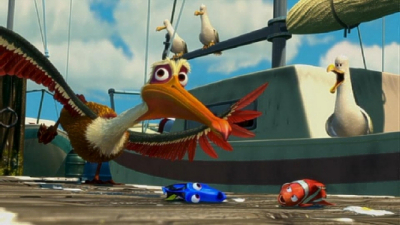
Scratch Tracks:
A good strong Dolby Digital EX track heads up this release and does a good job of approximating what a DTS track might have offered. The Dolby track is pretty aggressive for a film of this sort, down to the sound design of Skywalker Ranch/long-time Pixar collaborators, Garys Summers and Rydstrom. The track is perhaps therefore very comparable with Monsters Inc, featuring fun and pleasing uses of directional speakers. In the louder moments, a good system will put you right in the ocean, while the dialogue and other important effects are reproduced just as they should be. LFE is present, but maybe could have been used more in helping to conjure up the undersea world.
Marking a change from the Randy Newman-scored Pixar films of the past, his cousin Thomas steps up to the task here, with a very different take on action cues. Most recently lauded for the music for Road To Perdition, Newman has also written two of my favorite scores: Meet Joe Black and The Shawshank Redemption. He brings his string-based orchestrations to the fore in Nemo, providing warm themes juxtaposed with stark musical stabs. It’s a fine score that fits into the soundscape perfectly and contributes much to the underlying emotion as the story unfolds. All in all, a very enjoyable mix! English, French and Spanish subtitles are also included, though French and Spanish tracks are only available on the full-framed version.
Final Cut:
Apart from the annoying full-frame included transfer (that throws open the whole animation/open matte debate again, though kudos to Pixar again for providing a re-formatted frame that keeps the intention of the wider image intact), Finding Nemo’s supplements make this a great addition to the growing number of “must-have” DVDs. Coupled with the amazing film (an eventual Academy Award winner for Best Animated Feature) – it’s simply “fintastic”!
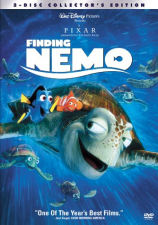 | ||
 |








